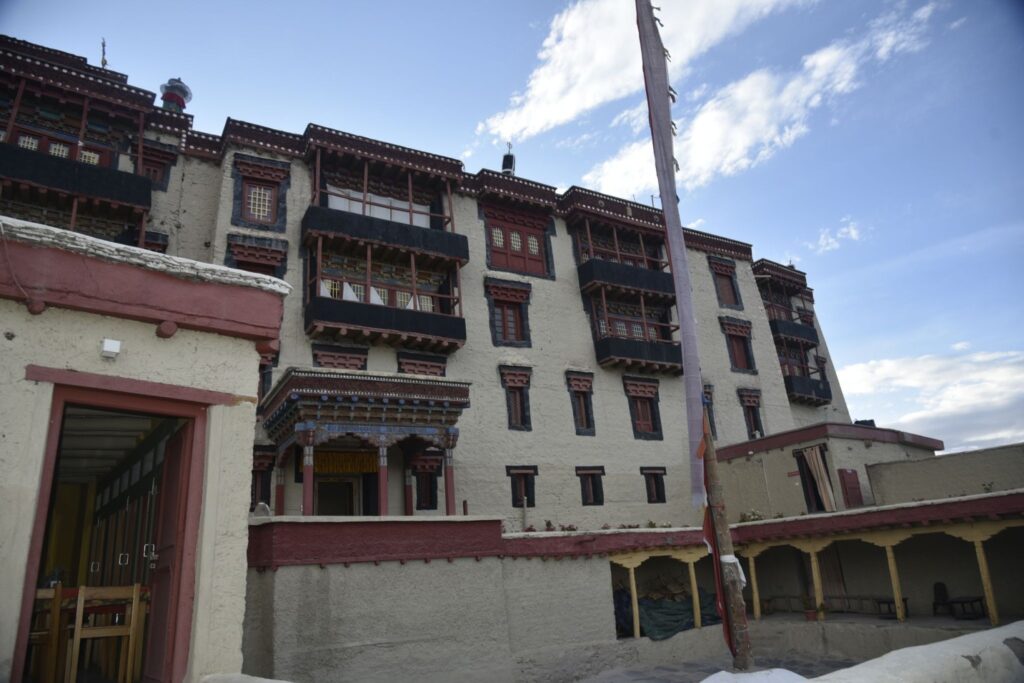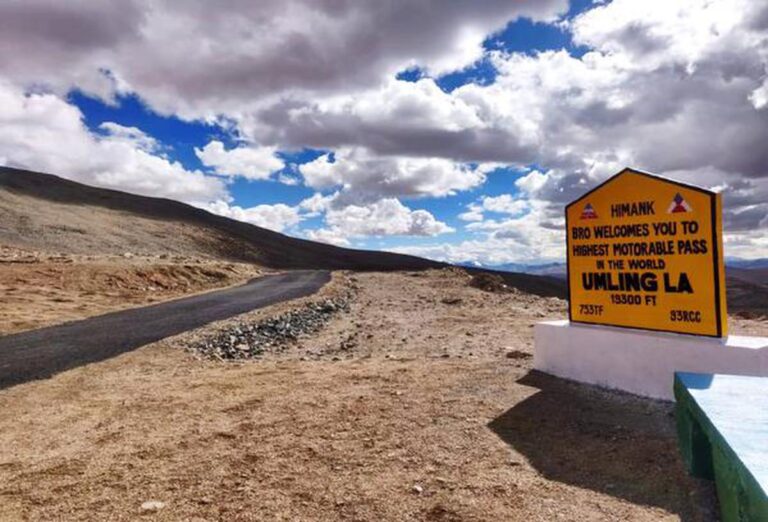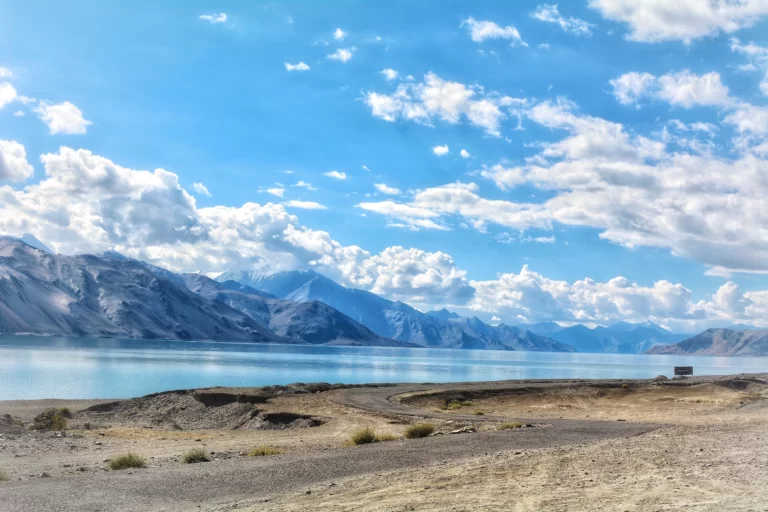Ladakh is not just known for its resilient landscape and breathtaking scenic beauty, it’s also known for magnificent monasteries. Tibetans are the dominant population that reside in Ladakh, as a result Ladakh has a rich Buddhist culture. Monasteries are also called Gompas which means “Solitary Places” in Ladakhi language. Monasteries in Ladakh are not the religious centres, its place to discover inner peace. Though there are monasteries in every village of Ladakh, none are similar to each other, each and every monastery gives a distinct experience to the visitor. Our resort in Ladakh is also surrounded by many famous monasteries of Leh and Ladakh.
Monasteries are the incarnation of Buddhism in Leh and Ladakh. Vivid colorful religious flags, whitewashed shrines, woody, cedar smell of Juniper whirling through the pleasant air, monks in traditional red robes perambulating around monasteries and stupas are usual yet attractive glimpses of Ladakh. Most of the monasteries date back to the 11th century but even today the old scriptures on the tall walls, architectural sculptures speak of Buddhist glory. Of Course all the monasteries are worth visiting but here we are looking at a few must visit monasteries in Ladakh to make your next Ladakh trip interesting.
Hemis Monastery

Hemis Monastery is one of the renowned historical and richest monasteries of Ladakh. Hemis Gompa belongs to the Drupka Lineage of Buddhism. Hemis monastery is located 40km far from Leh. This monastery was established in 1630 by Stagsang Raspa Nawang Gyasto during the rule of Singey Namgail, the king of Ladakh. This particular Gompa is built in Tibetan style of architecture. The ancient museum has a large collection of Tibetan books, Buddhist paintings on cotton and silk(Thangka) , a splendid copper idol of Buddha and Stupas immersed with pressure stones, and antique weapons that illustrate the heritage of Buddhist culture. Hemis Monastery attracts the visitors with 12m long Thangka, it’s the largest in Ladakh. Another worth mentioning attraction of this monastery is Hemis Festival, every year it takes place on the 9th and 10th day of the 5 month as per the Tibetan calendar. This religious event is devoted to Padmasambhava or Guru Rinpoche. Also once in 12year, the silk thangka of the Guru Rinpoche which is almost three centuries old, along with six bone accessories is displayed to the large number of devotees who visit Hemis festival from all over the world. Mask dance stands out as the unique attraction of this festival.

Alchi Monastery
Alchi monastery is one of the primeval monasteries in Ladakh. It was established by Rinchen Zangpo, the Tibetan scholar and a famous translator in the 12th century. Unlike other monasteries, this gompa is not on the hill top but on the plain land which is 70km drive from Leh. The Alchi Monastery is a fundamentally a complex which has, the largest part that is the assembly hall named as Du-khang, the Sumtseg, Manjushri temple/Jampe Lhakhang, Translator’s temple (Lotsawa Lhakhang) and Lhakhang Soma. The Sumtseg is renowned for the two storeyed long idol of four armed Bodhisattva. The building is marked with spectacular murals, sculptures and beautiful paintings on the walls which depicts the heritage and culture of Buddhist religion. Maybe for the reason to protect the masterpiece of paintings there is no electricity inside the monastery so it is suggested to carry the necessary torch or flashlight in order to see the painting on the walls of this gompa.
Stok Monastery and Palace

This Gompa is one among the must visit monasteries in Ladakh, situated 15km far from the South Leh. Stok Monastery is the splendid residence of the royal dynasty in Ladakh. Lama Lhawang established Stok Gompa in the 14the century. Also this monastery is the other part of our resort in Ladakh. The library of this Gompa has 108 volumes of Buddha’s preachings. The entry courtyard and veranda and the temple, Lhakchung on the top floor displays the prominent role of this palace in social and spiritual pursuits of the Ladakhis in the olden days. The main hall is embellished with the traditional thangkas. The frames of Vajrapani, Sukyamuni and Avalokitesvara are hung on the walls of this gompa.
The Museum at Stok has a very fascinating collection of Invaluable artefacts and antiquities of Ladakh’s old patrimony which can effortlessly attract historians and anthropologists. Currency of those times, noble seals, dignified costumes along with Crowns and headgears of Kings and Queens, valuable jeweler and Pictures are preserved in this Stok museum. Apart from all these, 400 year old thangkas collected by the royal family are showcased here. Swords, Shields, bows, arrows, quivers, guns and other warfare equipment are preserved in the separate room and undoubtedly those will take back the visitors to the Ladakh Kingdom.

In the month of June the mask dance takes place near the monastery. Every year in the month of February two days of Stok Guru Tsechu festival is conducted here, the most interesting part of the festival is the common man who has been selected and groomed by Lamas offers the prayer to the Deity.
Thiksey Monastery

Thiksey Monastery stands out from other monasteries in its size and glory. Of Course it’s the largest monastery in central Ladakh, it is situated 19km in the east of Leh. It is noted as this gompa bears a resemblance to Potala Palace which is in Lhasa, Tibet. The monastery is the dwelling place of the 15m tall Statue of Maitreya Buddha , also called as Future buddha and as Chamba in Ladakhi language, the statue occupies the two-storeyed building . The Idol of Maitreya Buddha is built in remembrance of the 14th Dalai Lama’s visit to this Gompa in the year 1970. The visitors can enjoy the stunning views of Stok Kangri peaks, Matho gompa, Shey palace from the roof terrace of this monastery.
Yelloe Hat sect maintain and take care of this place. During the month of October or December Gustor festival takes place here, the main attraction of this religious event is the trade fair where people from all over villages of Leh and Ladakh gather here to trade and socialize. The famous mask dance called Chhams is performed here too like any other festivals of Ladakh. At the end of the mask dance the dancer will do Sacrificial ceremony called as Argham , in real the mask dancers cut the sacrificial cake and distribute it to the gathering.
Karsha Monastery

Karsha Gompa is the most important and large monastery belonging to the Zanskar region. Karsha Gompa is also called by the name Karsha Chamspaling and it is situated in the Padum valley of the Zanskar region. The river Doda flows by the monastery. It was founded by the Tibetan translator, Phagspa Shesrab. This Monastery is dedicated to Padmasambhava. Ancient rock carvings, Anvalokiteshvara temple, Chukshikjal can be seen here. Chukshikjal has paintings which date back to the era of Rinchen Zangpo.The Gompa is spectacular with paintings of Lama Dzadpa Dorje, it houses the valuable artefacts and bone relics of Dorje Rinchen
Yellow hat sect Buddhist monks are in incharge and the younger brother of Dalai lama has the control of this Gompa. Karsha Monastery houses the statue of Lhaso Cho Rinpoche, the statue has a crown made of gold and stud with carnelian and turquoise decorations. Around 100 monks live in this monastery. Between 26th and 29th day of June month of the Tibetan calendar, the Gustor festival.
Ladakh is popular for the rugged landscape, motorable roads , Buddhist culture and Monasteries. Diskit Gompa being the largest and Lamayuru Gompa being the oldest monastery of Ladakh holds the pride of Buddhist heritage and culture.

